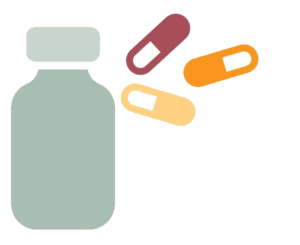August 7, 2020
An Introduction to Understanding Opioid Misuse and Addiction: Part 1
 In current news and social media, we see and hear about the opioid crisis. According to preliminary numbers from the Wisconsin Department of Health Services released on July 22nd, opioid overdoses in Wisconsin have increased 117% since the start of the COVID-19 pandemic. As a student pharmacist at the University of Wisconsin-Madison, School of Pharmacy, and in my time as a practicing pharmacist, I have frequently dealt with questions from providers, patients, and family members surrounding the necessity and safety of opioid pain relievers. We must work together as a community in order protect those who are most at risk from these medications, and we do that through understanding. In these series of blog posts, I plan to provide some common definitions surrounding the use, misuse, and addiction of prescription pain medications, to help clarify these commonly used phrases. This is just part 1 of a few posts I’ll be writing, so we’ll just focus on the prescription medications this time.
In current news and social media, we see and hear about the opioid crisis. According to preliminary numbers from the Wisconsin Department of Health Services released on July 22nd, opioid overdoses in Wisconsin have increased 117% since the start of the COVID-19 pandemic. As a student pharmacist at the University of Wisconsin-Madison, School of Pharmacy, and in my time as a practicing pharmacist, I have frequently dealt with questions from providers, patients, and family members surrounding the necessity and safety of opioid pain relievers. We must work together as a community in order protect those who are most at risk from these medications, and we do that through understanding. In these series of blog posts, I plan to provide some common definitions surrounding the use, misuse, and addiction of prescription pain medications, to help clarify these commonly used phrases. This is just part 1 of a few posts I’ll be writing, so we’ll just focus on the prescription medications this time.
Throughout all of my posts, I’ll be using a lot of information from the Centers for Disease Control and Prevention (CDC) website, which is a great resource for information on opioid use and abuse.
Let’s start with the main question… What is an opioid?
- Opioid pain relievers are a group of medications that reduce our perception of pain in our brains. These can be broken down into three groups—natural, semi-synthetic, or synthetic—examples of which include morphine, codeine, oxycodone, hydrocodone, methadone, tramadol, and fentanyl to name a few. See below for a list of brand and generic names of these medications.
The illicit drug heroin would also be considered an opioid, but it no longer has true, safe, medicinal purposes.
What makes all these medications similar is that they will act on the same place in your brain that provides pain relief. The prescription opioid medications are often used to treat acute (short-term) or chronic (long-term) pain disorders that can come from injuries or other conditions.
- The CDC defines chronic use of opioids as consistent opioid use extending longer than three months.
As with all effective medications, the use of opioids comes with potential side effects. All the medications carry a risk for addiction, but that will be discussed more in my next post. Common side effects are:
| Ø Constipation | Ø Itching |
| Ø Drowsiness | Ø Depression |
| Ø Nausea and/or vomiting | Ø Dry mouth |
More serious, but less common side effects can include:
| Ø Addiction | Ø Extreme drowsiness | Ø Slowed rate of breathing |
These levels of drowsiness or slowed breathing can be deadly and are usually caused by taking too much of the opioid pain reliever, but that level can happen at different amounts for different people. This is why it is so important to only take these medications when working with a doctor or other healthcare provider and to take them as they tell you to. Each specific opioid can carry their own specific side effects as well so be sure to check with your pharmacist to make sure you understand what to look for if/when you need to take an opioid pain reliever. Other commonly used terms in regards to opioids can be found on the CDC website.
In the next post, we’ll tackle more specifics on the addiction process and how we can prevent that from happening.
If you feel like you or a loved one is struggling with opioid addiction there are resources available for you. Please, visit the Wisconsin Department of Health Services website for opioid treatment resources, a hotline, and treatment program locations.
Common Opioid Pain Relievers
| Generic Name | Brand Names (not all inclusive) |
| Natural | |
| Morphine | Doloral®, Statex®, Roxanol®, MS Contin®, Kadian®, AVINza®, Morphabond ER® |
| Codeine | Tylenol® #2,3,4 (with acetaminophen) |
| Semi-Synthetic | |
| Hydrocodone | Vicodin®, Norco®, Lortab®, Lorcet®, Anexsia®, Zydone®, Maxidone® |
| Hydromorphone | Dilaudid® |
| Oxycodone | OxyNEO®, Percocet®, Oxycocet®, Percodan®, OxyContin®, Xtampza ER® |
| Synthetic | |
| Fentanyl | Abstral®, Duragesic®, Onsolis®, Sublimaze® |
| Tramadol | Ultram®, Tramacet®, Tridural®, Durela®, Ryzolt® |
| Methadone | Methadose®, Dolophine® |
| Tapentadol | Nucynta® |
| Buprenorphine | BuTrans®, Belbuca®, Probuphine®, Sublocade® |
| Buprenorphine-naloxone | Suboxone®, Bunavail®, Zubsolv®, Cassipa® |
